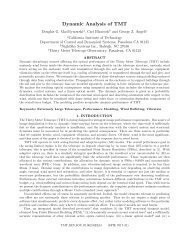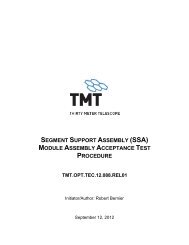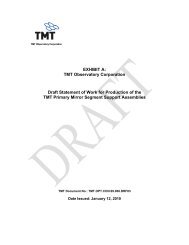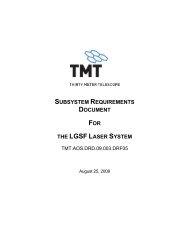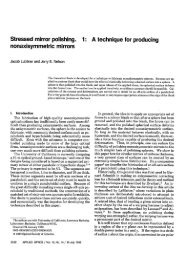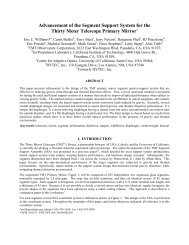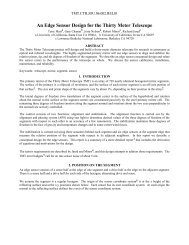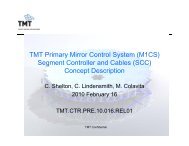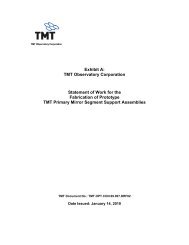TMT Construction Proposal - Thirty Meter Telescope
TMT Construction Proposal - Thirty Meter Telescope
TMT Construction Proposal - Thirty Meter Telescope
You also want an ePaper? Increase the reach of your titles
YUMPU automatically turns print PDFs into web optimized ePapers that Google loves.
What is the nature and composition of the Universe<br />
Ordinary matter can generally be detected directly, from the light emitted by<br />
stars, from radiation emitted by hot gas in galaxies and clusters, and by<br />
absorption of light from background luminous sources. We can infer the<br />
presence of dark matter from its gravitational attraction, which affects the<br />
motion of galaxies and the propagation of light. In contrast, the gravitational<br />
effect of dark energy is repulsive, manifested by an increase in the rate of<br />
expansion of the Universe. A census of these components reveals the<br />
surprising result that normal matter accounts for only a small fraction of the<br />
composition of the Universe– the rest is dominated by dark energy and dark<br />
matter. Closely related to the question of the composition of the Universe, is its<br />
dynamical history. The inflationary period that produced the observable<br />
Universe is believed to have been driven by a form of dark energy – a scalar<br />
field. Incredibly, the earliest moments of the Big Bang, involving physics on the<br />
smallest scales, can be probed by observations of the large scale structure of<br />
the Universe.<br />
Fig 2-2: Composition of<br />
the Universe.<br />
When did the first galaxies form and how did they evolve<br />
By looking into space to greater and greater distances, we are able, thanks to the finite speed of light, to see<br />
further and further back into the past. To see the very first stars and galaxies we must look over enormous<br />
distances, some 13 billion light years. So far these objects remain beyond the reach of present telescopes. At<br />
lesser distances, moving forward in time, we see galaxies interacting dynamically and forming stars. But it is<br />
not yet clear how this produces the diversity of galaxy types that are seen today.<br />
What is the relationship between black holes and galaxies<br />
There is now overwhelming evidence that black holes exist, and that black holes with as much as a billion times<br />
the mass of the Sun occupy the centers of galaxies. But, we don’t know when or how these supermassive<br />
black holes formed, or how they fit into the overall picture of galaxy formation and evolution.<br />
How do stars and planets form<br />
Stars form within molecular clouds, by a combination of complex physical processes. What determines when<br />
these clouds form stars What determines the masses of these stars What fraction have planetary systems<br />
There are many questions we are just beginning to explore.<br />
What is the nature of extra-solar planets<br />
The exoplanets detected so far are gas giants like Jupiter and Neptune. They were discovered because their<br />
large mass noticeably perturbs the motion of the host star. Surprisingly, many are found very close to their host<br />
star. As the higher temperatures from near proximity would prevent such planets from forming, it seems they<br />
must have migrated inward after first forming at greater distances. We believe that smaller terrestrial planets<br />
exist, but these cannot be detected with present telescopes. Are such planets common Can they survive the<br />
disruption that would result from migration of the massive planets Do they have atmospheres like Earth<br />
Is there life elsewhere in the Universe<br />
If terrestrial planets exist, are conditions conducive to the development of life Each star has a habitable zone,<br />
where a planet would have a surface temperature comparable to Earth’s. If, as expected, exoplanetary systems<br />
have populations of small icy bodies like comets, it is possible that water and organic molecules could have<br />
been delivered to such planets by impacts. If life then develops, it might be detected by signatures of biological<br />
activity in planetary atmospheres.<br />
2.1.3 The required tools<br />
To answer these and many other questions, advances in technology are needed. The greatest progress will<br />
come from combined studies at many different wavelengths using ground and space-based facilities. Several<br />
major new telescopes will begin operation in the next decade, including the James Webb Space <strong>Telescope</strong><br />
(JWST) and the Atacama Large Millimeter Array (ALMA). Soon to follow will be the Square Kilometer Array<br />
(SKA). By providing powerful new capabilities at optical, infrared, microwave and radio wavelengths, these<br />
facilities will open new frontiers. Yet they alone will not be sufficient. Much as the resolution of the Hubble<br />
Space <strong>Telescope</strong> was complemented by the greater light gathering power of the Keck 10-meter telescopes,<br />
these upcoming facilities will require a complementary large-aperture ground-based telescope to provide high<br />
spatial and spectral resolution observations in the optical and infrared. In fact, a revolution in technical<br />
capability now makes ground-based telescopes even more effective. Adaptive optics (AO) systems allow the<br />
largest optical-infrared telescopes on Earth to achieve higher resolution than telescopes in space, which<br />
<strong>TMT</strong> <strong>Construction</strong> <strong>Proposal</strong> 6



